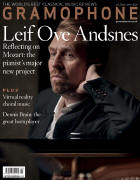Texte paru dans: / Appeared in: |
|
|
Outil de traduction (Très approximatif) |
|
|
Reviewer:
Rob Cowan There is no shortage of fine modern players capable of making magic out of Bach’s works for unaccompanied violin. Alina Ibragimova has been described as ‘enthralling’, and Rachel Podger has won similar plaudits. But compare them in the Largo from the Third Sonata, and although both subscribe to a period-performance aesthetic, you could hardly imagine two players sounding less alike, Ibragimova elegant and refined, Podger drawing a maximum of sonority from each note – and yet they both clock in at exactly 3'20". Turn then to Augustin Hadelich, who uses a Baroque bow, and you’re in a different world entirely. Quite aside from the broader pace (4'08"), the mood is solemn, reflective and aria-like. His approach to the faster movements stresses the music’s proneness to caper and in the Chaconne from the Second Partita, after the wildly arpeggiating passage and the recap of the principal theme, in other words the midway point (at 6'51"), we switch from precipitous flight to hushed prayer, while the arpeggios soon afterwards take off at a reckless speed. It’s an exciting rendition, whereas the Fugue and inversion from the Third Sonata prefers to dance, quite an unusual option. Other fugues are direct, no-nonsense affairs, with plenty of light and shade; and because of the bow used, largely free of unpleasant chordal ‘scrunching’. The fast finales also benefit from informed virtuosity, the First Partita with its alternately mirroring Doubles full of variety, the Second Sonata’s finale replete with echo effects. Hadelich’s approach makes listening to the cycle at a single sitting relatively easy: sleight of hand and a strong musical imagination keep you hooked for the duration. As to where he stands in the overall digital scheme of things, Ibragimova, Podger, Ning Feng and Ilya Gringolts (in Partitas Nos 1 and 3 and Sonata No 2 – DG, 11/03) are similarly arresting. There are a few embellishments (including a prominent trill at the close of the First Partitas’s presto Double, which is played at lightning speed) but otherwise nothing to frighten the horses. The only quality that those of a certain age might yearn for is the sort of emotional ‘tug’ that players such as Grumiaux, Milstein, Perlman, Szeryng and Heifetz prompt, but then you already know that, don’t you. In other respects, a fine set, well worth exploring.
|
|




